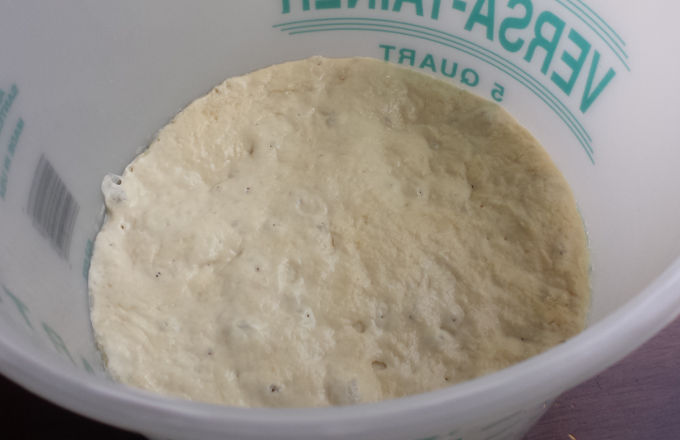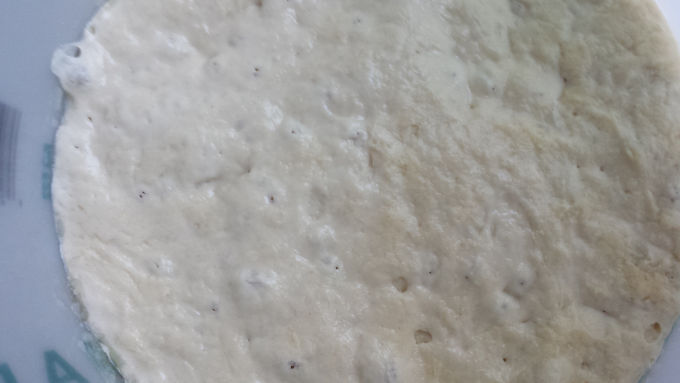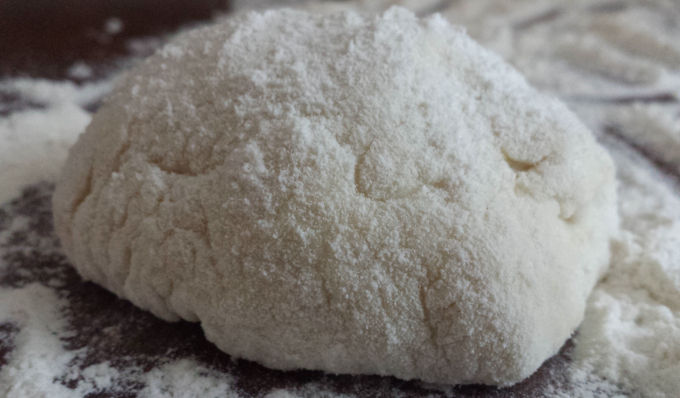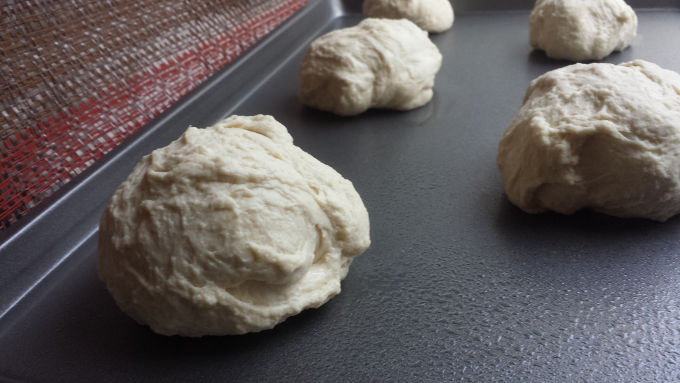
This is what my pizza dough looked like after three days in the refrigerator.
Where do I even begin with this one. Well actually, I have a pretty good idea of where to begin, but before I can do that, I need to make two things clear. First, I don’t think the perfect pizza dough actually exists – nor can it ever – because it is such a subjective thing. Granted, there appears to be a lot of like minded opinions on things such as chewiness or how dense the dough should be.
However, I would call those opinions more of a common thread that seems to be an acceptable standard that most pizza makers strive for. But by no means does that make anything correct or incorrect when it comes to making great tasting pizza dough (at least in my opinion). Thinner New York style pizzas versus deep dish Chicago style pizzas; it’s impossible for me to decide.
The second thing I would like to make clear, is that now that I have given you my opinion on “The Quest For The Perfect Pizza Dough” I can fall back into my comfortable waste of time (for you as the reader) routine. That’s right, my signature writing style featuring lots of prattling and meandering with only minimal intelligence (I seriously struggled to spell that last word right) and less than inspired ideas. And for that, you are welcome.
Anyway, I have recently become curious about letting the pizza dough do a slow rise in the refrigerator for forty-eight to seventy-two hours. It’s most likely a byproduct of my increasing fascination with improving my pizza dough making techniques. I truly think it’s beginning to border on obsessive. But who cares? NOT ME!
So I have a quick same day pizza recipe already posted on this site: Basic Pizza Dough (Same Day Recipe). It gets the job done and is indeed quite good, but it’s just not a recipe that I would ultimately be satisfied with. Part of the problem for me though, and one that is going to be a real problem over time as I refine my recipe, is the temperature at which the pizza dough should be cooked at. I’m discovering that the 500° F (260°C) max temperature of our oven just isn’t going to do the job for the type of pizzas I want to make. It will work for thick pizzas that need to be cooked at a lower temperature, but not for something like a Neapolitan style pizza.

What I need is a wood fired brick oven. But, somehow I don’t see that happening. So you can see the predicament I’m finding myself in. After a little thought on the matter, the only logical solutions I have come up with are the following:
A: Hope for the best this Christmas by dropping a few not so subtle hints to my family and friends that dropping a few grand on an oven would be an excellent investment.
2: Build myself a fancy brick oven in the back yard. The only problem with that idea, is that I have no clue how to do that, and quite frankly I am great at starting projects but never finishing them. Then we all know that if you have a brick oven in your backyard you’re going to need some seating arrangements so you can wait for your pizza to cook in comfort. And then what if it starts raining? Well, then you have to find a way to keep your pizza and your seats dry. The solution is building a small gazebo. I wouldn’t mind that actually but as you can see it just never ends.
D: Just do without. I don’t particularly like this idea much, so I might just google, “how to build your very own wood fired pizza oven for the backyard complete with mini gazebo for under $50” and see what kind of results I can get.
If none of the above comes to fruition, I’m afraid I will simply have to wait until Santa Claus brings me my very own wood fired brick oven. And maybe a nice pizza peel, and some cornmeal too. Hey, it could happen.
But let me share with you what I accomplished this week regarding pizza. I bought a frozen pizza from the store and added extra toppings to it. It was pretty good.
In other news, three days ago I whipped up some pizza dough in the mixer and have been letting it do a slow rise in the refrigerator. Let me do some quick math because we all know how adept I am at that. Or is it inept…
Either way, it’s one of those two words. Currently, it is a beautiful Thursday afternoon. I’m sitting at our computer and typing while it continues to be a beautiful Thursday afternoon. Here’s the math part. I made the dough Monday afternoon and put it in a large plastic tub (I gave it a light coating of olive oil) with a lid, and put it in the fridge. Fast forward to today, (being a beautiful Thursday afternoon) and if my math is correct, the dough has been chilling (pun intended) for a solid seventy-two hours.

Wait, what is this? It looks like some sort of weird dessert. Not professional looking at all!
In between finishing up this post, I took the dough out and folded it into different sized dough balls and put them on a sheet pan covered with a plastic bag. I will let them continue to rise in the fridge for another 4 – 5 hours. When it comes time for dinner, I’ll roll them out and everyone will get to make their very own personal pizza. I wanted to come up with a good name for make your own pizza night, so I decided to call it “make your own pizza night.”
A few more quick notes. As I tweak this recipe and get it closer to where I want it to be, I will be incorporating some different kinds of flour; namely the Napoli brand. And after I get more familiar with that flour I will begin adding more information in later posts.
But for this dough, I used;
- cold water
- active dry yeast
- King Arthur brand bread flour: (it has more protein than all purpose flour)
- semolina flour
- sea salt
And that’s it. When the yeast is allowed to take it’s time, which is what happens during a slow rise, you will be rewarded with a much more complex flavor from your dough. Now I really sound like I know what I’m talking about huh?
So with all that being said I will end this post with a quote from another website. My recommendation to you, if you actually want to learn something about slow rising and why it works like it does, is to go check out this website: Serious Eats.com
The warmer the dough is during fermentation, the faster the yeast multiply and produce carbon dioxide (carbon dioxide production rate maxes out at around 90°F). So with very simple recipes, this entire process can take place in just a few hours. But experienced bakers and pizza-makers know that this is not the best way to make dough. Though yeast produces carbon dioxide rapidly at high temperatures, it also produces undesirable flavors. Rather than tasting rich and complex, hastily made breads have the one-dimensional flat flavor of the flour, and sometimes even develop off flavors, like sour milk..
– seriouseats.com –

Real cooks can actually make these bad boys round. This, well it will eventually become round.


2 comments on “The Quest For The Perfect Pizza Dough”
Seriously, why have I not been reading your blog this whole time? HI-LAR-I-OUS.
Thank you very much for the kind words. I don’t really consider myself a funny person, but as Vanessa has probably told everyone, I don’t do so well when my ‘rules’ are compromised… Yeah, I know. It’s a thing for me.
I think everything I write stems from that character uh… trait, along with the fact that I don’t know what I’m doing half the time. So why not be honest?
Hey! That reminds me. I need to get some pizza dough going so it will be ready for the weekend. I find that a 4 day slow rise in the fridge makes the pizza dough taste absolutely amazing. Oh, and on a different note, do you happen to know anyone that is able or willing to build a brick fired oven that is capable of reaching temps somewhere around 900°F (480°C)?
Don’t answer that. It was just a joke because I think I will try my hand at it. My goal would be to not set the neighborhood on fire.